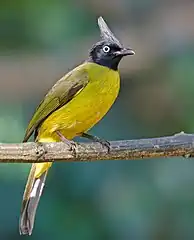| Rubigula | |||
| Blyth, 1845[1] | |||
 Przedstawiciel rodzaju – bilbil żółtobrzuchy (R. flaviventris) | |||
| Systematyka | |||
| Domena | |||
|---|---|---|---|
| Królestwo | |||
| Typ | |||
| Podtyp | |||
| Gromada | |||
| Podgromada | |||
| Infragromada | |||
| Rząd | |||
| Podrząd | |||
| Rodzina | |||
| Rodzaj |
Rubigula | ||
| Typ nomenklatoryczny | |||
|
Turdus dispar Horsfield, 1821 | |||
| Synonimy | |||
|
| |||
| Gatunki | |||
| |||
Rozmieszczenie geograficzne
Rodzaj obejmuje gatunki występujące w południowej i południowo-wschodniej Azji[5][6].
Morfologia
Długość ciała 16–19,5 cm; masa ciała 16–34 g[6].
Systematyka
Rodzaj zdefiniował w 1845 roku angielski zoolog Edward Blyth w artykule poświęconym nowym lub mało poznanym ptakom opublikowanym w czasopiśmie The journal of the Asiatic Society of Bengal[1]. Blyth wymienił trzy gatunki – Turdus dispar Horsfield, 1821, Brachypus gularis Gould, 1836 i Ixos squamatus Temminck, 1828 – z których gatunkiem typowym jest (późniejsze oznaczenie) Turdus dispar Horsfield, 1821 (bilbil czerwonobrody)[7].
Etymologia
- Rubigula: średniowiecznołac. rubinus ‘rubin’, od łac. rubeus ‘czerwony’, od ruber ‘czerwony’; łac. gula ‘gardło’[8].
- Ixodia: rodzaj Ixos Temminck, 1825 (szczeciak); gr. -ωδης -ōdēs ‘przypominający’[9]. Gatunek typowy (oznaczanie monotypowe): Pycnonotus cyaniventris Blyth, 1842.
- Ixidis: wariant pisowni rodzaji Ixodia Blyth, 1845[10].
- Squamatornis: łac. squamatus ‘łuskowaty’, od squama ‘łuska’; gr. ορνις ornis, ορνιθος ornithos ‘ptak’[11]. Gatunek typowy (oryginalne oznaczanie): Ixidia weberi[uwaga 2] Hume, 1879.
Podział systematyczny
Do rodzaju należą następujące gatunki[12]:
- Rubigula erythrophthalmos (Hume, 1878) – bilbil złotooki
- Rubigula cyaniventris (Blyth, 1842) – bilbil szarobrzuchy
- Rubigula squamata (Temminck, 1828) – bilbil łuskowany
- Rubigula flaviventris (Tickell, 1833) – bilbil żółtobrzuchy
- Rubigula melanictera (J.F. Gmelin, 1789) – bilbil czarnoczuby
- Rubigula gularis (Gould, 1836) – bilbil rubinowy
- Rubigula dispar (Horsfield, 1821) – bilbil czerwonobrody
- Rubigula montis Sharpe, 1879 – bilbil żółto-oliwkowy
Uwagi
Przypisy
- 1 2 Blyth 1845 ↓, s. 576.
- ↑ Blyth 1845 ↓, s. 576.
- ↑ E. Blyth. Notices and Descriptions of Various New or Little Known Species of Birds. „The Journal of the Asiatic Society of Bengal”. 15 (169), s. 50, 1846. (ang.).
- ↑ E.Ch.S. Baker. Squamatornis, gen. nov, type Rubigula squamata webberi. „Bulletin of the British Ornithologists’ Club”. 49 (327), s. 40, 1928. (ang.).
- ↑ Frank Gill & David Donsker (red.): Bulbuls. IOC World Bird List: Version 13.2. [dostęp 2024-02-04]. (ang.).
- 1 2 D.W. Winkler, S.M. Billerman & I.J. Lovette, Bulbuls (Pycnonotidae), version 1.0: Rubigula, [w:] S.M. Billerman, B.K. Keeney, P.G. Rodewald & T.S. Schulenberg (redaktorzy), Birds of the World, Cornell Lab of Ornithology, Ithaca, NY 2024, DOI: 10.2173/bow.pycnon4.01 [dostęp 2024-02-01] (ang.).

- ↑ G.R. Gray: Catalogue of the genera and subgenera of birds contained in the British Museum. London: The Trustees, 1855, s. 47. (ang.).
- ↑ The Key to Scientific Names ↓, Rubigula [dostęp 2024-02-04].
- ↑ The Key to Scientific Names ↓, Ixodia [dostęp 2024-02-04].
- ↑ The Key to Scientific Names ↓, Ixidis [dostęp 2024-02-04].
- ↑ The Key to Scientific Names ↓, Squamatornis [dostęp 2024-02-04].
- ↑ Systematyka i nazwy polskie za: P. Mielczarek, M. Kuziemko: Rodzina: Pycnonotidae Gray,GR, 1840 - bilbile - Bulbuls (wersja: 2024-01-06). [w:] Kompletna lista ptaków świata [on-line]. Instytut Nauk o Środowisku Uniwersytetu Jagiellońskiego. [dostęp 2024-02-04].
Bibliografia
- E. Blyth. Notices and Descriptions of various New or Little Known Species of Birds. „The journal of the Asiatic Society of Bengal”. 14 (2), s. 546–602, 1845. (ang.).
- The Key to Scientific Names, J.A. Jobling (red.), [w:] Birds of the World, S.M. Billerman et al. (red.), Cornell Lab of Ornithology, Ithaca (ang.).
This article is issued from Wikipedia. The text is licensed under Creative Commons - Attribution - Sharealike. Additional terms may apply for the media files.